10 Things You Didn’t Know About Watches
Decades of history, science and exploration have left their mark on today’s top models
1. Wristwatches were first designed for women

The first wristwatch was made for Countess Koscowicz of Hungary by manufacturer Patek Philippe of Switzerland in 1868. Tied on with ribbons and intended primarily as a piece of decorative jewellery, it did not go down well with the gentlemen of the day, who preferred pocket watches. “I’d sooner wear a skirt!” was the stock response. Men’s wristwatches only became a “thing” during World War I, when soldiers cottoned onto their practicality while carrying out newfangled timed artillery attacks. When Tommy and Fritz trudged home, the military watch became the must-have accessory – as worn by war heroes.
Hamilton has an illustrious military heritage. Alongside army watches, it manufactured WW2 bomb timers, which were mounted to an aircraft’s bombsight in conjunction with a movie camera to record the precise time of detonation. This contemporary military ticker, waterproof to 100m, is a nod to Hamilton’s heritage. Hamilton Khaki Field Quartz, £310, hamiltonwatch.com
2. Diving watches are tested until they implode
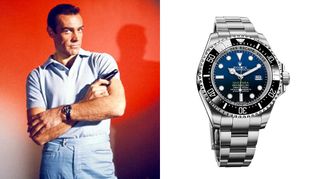
The Rolex Submariner, as worn by 007 in the Sean Connery Bond films, was the first watch to be water resistant down to 100m and is still considered the most wearable diving watch today. Rolex tests each and every Deepsea – the professional model – in a 1.3 tonne hyperbaric chamber that simulates the pressure at 4,875m. It’s an expensive process: the tiniest flaw will cause a watch to implode. Meanwhile, Swiss firm Clerc is testing its next generation of diving watches by strapping them to submarines. So, yes, you’ll be fine wearing it in the shower.
Pitched at professional divers and treasure hunters, the Deepsea is waterproof to a depth of 3,900m. The case is made from a superalloy, while the Glidelock clasp allows it to slip over a wetsuit. A helium escape valve means that divers can wear it whilst decompressing in a hyperbaric chamber. Rolex Oyster Perpetual Deepsea, £9,150, rolex.com
3. You can thank polo players for the sports watch
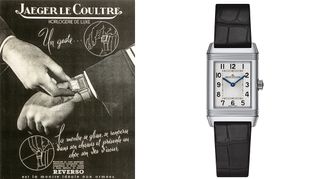
The gentlemanly sport of polo isn’t actually that gentlemanly; players tend to get whacked by 4ft mallets and cracked over the head by rock-hard balls that ping off a hoof at 110mph. But you can credit this perilous game for the invention of the first sports watch. In the ’30s, a group of polo-loving army officers in British India challenged watchmaker Jacques-David LeCoultre to design a suitably-tough ticker. The result was the Reverso, the first ever “sports watch”, featuring an ingenious case that flipped over to protect the glass.
The design of the Reverso has barely changed since the ’30s; it features the same geometric case that glides sideways and flips over to protect the glass. The world’s top polo players still rely on these to time a seven-minute chukker, though you’re more likely to spot them on the wrists of Hollywood stars. Jaeger Le Coultre Reverso Classic Large, £6,650, jaeger-lecoultre.com
RECOMMENDED: The Best Sports Watches
Get the Coach Newsletter
Sign up for workout ideas, training advice, reviews of the latest gear and more.
4. Brit watchmakers are sticking it to the Swiss
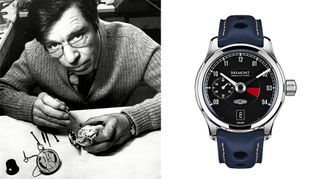
Much to the chagrin of the Swiss, Britain produced the greatest watchmaker of the 20th century. George Daniels was one of the only men in the world capable of building a complete watch by hand and best known for inventing the ultra-reliable co-axial movement. More recently, British brothers Nick and Giles English have wowed the Swiss with their revival of the aviation-themed Bremont brand, moving the manufacturing from Switzerland to Henley-on-Thames.
Tom Cruise, who pilots his own Gulfstream jet, regularly wears his Bremont. But while the firm is best known for its aviation-themed watches, they do smart racing ones, too. This, a lightweight automatic winder, was made to celebrate the Jaguar E-type’s anniversary. Quite possibly the most British thing ever. Bremont Jaguar MKI, £8,395, bremont.com
5. NASA has only ever approved one “moon watch”

If the thought of owning a watch that was worn on the moon butters your parsnips, then good news. The modern Omega “moon watch” is almost identical to the one worn by Buzz Aldrin in 1969 [Neil Armstrong left his behind in the lunar module]. Still the only watch approved by NASA for “Extra Vehicular Activity” – space walks – the Omega was chosen as it was the only timepiece to survive NASA’s rigorous testing. The others had issues like, er, “melting”.
As worn on all six moon landings, and used by the Apollo 13 astronauts to time their heroic re-entry. It comes with spare NATO/Velcro straps, plus a loupe and tools. The self-winding co-axial movement is super-reliable; Gene Cernan, the last man on the moon, claims he’s never even had his serviced. Omega Speedmaster Moonwatch Professional Chronograph, £5,540, omegawatches.com
6. Quartz almost destroyed Swiss watchmaking
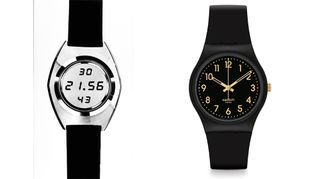
In the ’70s, mighty Swiss watchmaking suddenly began to melt away faster than a Toblerone on the back seat of a Consul. What brought about those dark days? Quartz crystals. Combined with an electronic oscillator, quartz produces a precise radio frequency that keeps time more accurately than a mechanical watch. Quartz watches also have no need for cogs, springs or gears – there’s nothing to wind. The “quartz crisis” eased up when the Swiss began to shout – loudly – about the merits of superior craftsmanship.
Founded in 1983, Swatch helped to save the Swiss watch industry from death-by-quartz. It took quartz technology, but used it in fashionable plastic watches that helped to repopularise analogue dials. The iconic 1983 Gent line was such a success that Swatch still makes it. Swatch Gent Golden Tac, £38, shop.swatch.com
RECOMMENDED: Cool Men’s Watches And Outfits to Wear Them With
7. Casio tested the first G-shock by throwing it out of a window
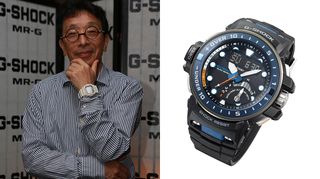
These days watchmakers use headline-grabbing tests to prove “toughness” (even running them over with a tank). But tough watches – affordable ones – didn’t exist until 1981. When Casio engineer Kikuo Ibe dropped and broke the watch his father had passed down, he set out to make a replacement that would withstand the “triple 10” (10m drop, water resistant to 10 bars and 10-year battery life). Banned from using Casio’s lab for his unofficial project, he drop-tested prototypes by chucking them out of the window in the bathroom. Classy? No. Inspired? Yes.
The hugely popular G-shock (the ‘G’ stands for gravity) is a mix of fashion and functionality. There are hundreds of models for you to choose from, including ones with functions like DJ tools for song-mixing. This particular model solar-charges and features a digital compass. Casio G-Shock GWN-1000GB-1AER, £700, g-shock.co.uk
8. You need specialist training to wear this survival watch
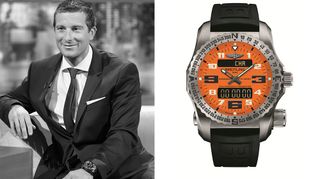
What do urine-guzzling explorer Bear Grylls and meme-friendly action hero Steven Seagal have in common? They both wear a very special watch. So special, in fact, that you’ll have to submit to specialist training before you buy one. The Breitling Emergency is the only watch in the world with a built-in personal distress beacon. Pull the pin, and it will summon search and rescue. Lives have already been saved, though there have been false alarms too (hence the training). Seagal rocks an 18K gold model, naturally.
This survival watch is equipped with a Personal Locator Beacon to alert and guide search-and-rescue teams. Shrinking a powerful dual antennae into a watch case is a technological feat unlikely to be repeated. What’s more, it’s rated to -20C, a temperature that would freeze the oils in a normal watch. Breitling Emergency II, from £12,750, breitling.com
9. Silicon Valley invented smartwatches in 1977

When Hewlett-Packard introduced the HP-01 in 1977, it was billed as the “watch that could do anything”. It was a fib, of course, but using its LED display, calculator and time-zone functions, the wearer could work out the cost of a long-distance phone call. Japanese firms such as Casio and Seiko soon improved upon its design, creating the first “wearable computers” in the ’80s. Popular with Yuppies and naughty schoolboys, the wrist-computer morphed into TV watches and Nintendo’s Super Mario Bros wristwatch.
Phone-watches failed spectacularly in the Noughties, so Apple has sensibly aimed its smartwatch at fitness fans. The newest Apple Watch has built-in GPS (no need to keep your phone close by) and is water resistant to 50m. Don’t like running or swimming? It can also find a cool bar – and get you an Uber home. Apple Watch 2, from £269, apple.com
10. Watches can even have lasers… and a cigar lighter

Cigarette lighters, jet fighter parts, meteorites from Mars, drum machines and even scraps of the Wright Brothers’ plane – there’s not much that hasn’t found its way into a watch. Pretty much everything but a grapple hook, and that’s surely just a matter of time. But when it comes to masculine, gadget-laden timepieces, look no further than the suitably-named Snyper, which comes with a laser sight and a windproof cigar lighter.
The testosterone-fuelled watch of Instagram king Dan Bilzerian’s dreams, this grade 5 titanium watch can be accessorised with an optional laser-sight module and a zinc alloy cigar lighter. Essentially, you will look like you’ve strapped a tiny bazooka to your wrist. Good luck getting it through airport security. Snyper ONE, from £7,500, snyperwatches.com
Coach is a health and fitness title. This byline is used for posting sponsored content, book extracts and the like. It is also used as a placeholder for articles published a long time ago when the original author is unclear. You can find out more about this publication and find the contact details of the editorial team on the About Us page.

